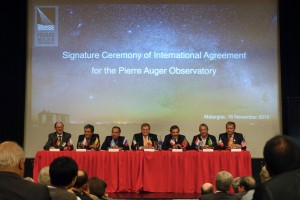 On 16 November, Dr. Paula Gina Isar, researcher at the Institute of Space Science (ISS) and institutional representative at the Pierre Auger Observatory, took part together with other Romanian researchers at the signature ceremony of a new International Agreement for continued operation of the Observatory until 2025. The event took place during the AugerPrime Symposium, which was held from 15 to 16 November 2015 in Malargüe, Argentina, to celebrate 15 years of achievements and the AugerPrime upgrade to the Observatory. The International Collaboration counts about 450 scientists from 16 countries and 82 institutions. Former associated country during 2011-2014, Romania became a full member state of the largest cosmic ray experiment in the world in 2014.
On 16 November, Dr. Paula Gina Isar, researcher at the Institute of Space Science (ISS) and institutional representative at the Pierre Auger Observatory, took part together with other Romanian researchers at the signature ceremony of a new International Agreement for continued operation of the Observatory until 2025. The event took place during the AugerPrime Symposium, which was held from 15 to 16 November 2015 in Malargüe, Argentina, to celebrate 15 years of achievements and the AugerPrime upgrade to the Observatory. The International Collaboration counts about 450 scientists from 16 countries and 82 institutions. Former associated country during 2011-2014, Romania became a full member state of the largest cosmic ray experiment in the world in 2014.
The new Agreement signed on 16 November 2015 will provide the basis for doubling the data set with the upgraded Observatory and for solving the long-standing puzzle of the origin of the most energetic particles in the Universe.
„During the next decade, we will continue to explore fundamental particle physics at energies beyond those obtained at the argest ground-based particle accelerators”, said Gina Isar, scientific researcher at the Institute of Space Science (ISS).

The AugerPrime upgrade to the Observatory enhances the 1660 existing surface detectors (water tanks sensitive to Cherenkov light generated by the shower products) with new scintillation detectors, so that electromagnetic and muonic shower particles can be separated more efficiently. This in turn, together with smaller area of buried muon detectors, improves the determination of the mass of the primary cosmic rays, otherwise not directly measurable. Faster and more powerful electronics also facilitate the readout of the new detector components and enhances the overall performance of the Observatory elements.
“We are honored to take part in this symposium, which presents the efforts and contributions of all the partners involved in this international Collaboration, including Romania. We’re confident that the upgrades will contribute to remarkable new results from the Observatory”, said Gina Isar, who represents the Institute of Space Science (ISS) at the Pierre Auger Observatory, where Romania is also represented by the Institute of Physics and Nuclear Engineering “HoriaHulubei”, the University of Bucharest and the Politehnica University of Bucharest.
Outstanding results
Results from this international Collaboration have brought new fundamental insights into the origin and nature of highest-energy cosmic rays. One of the most exciting results is the experimental proof that at the highest energies (7 orders of magnitude above what can be achieved at CERN’s Large Hadron Collider) the cosmic-ray flux decreases much faster than at low energies. Data indicate that this flux suppression marks the limiting energy of the most powerful cosmic particle accelerators.
The outstanding results achieved during the years strengthen the decision to extend lifespan of the Pierre Auger Observatory. An even more detailed measurement of the nature of cosmic particles at the highest energies is crucial to understand the mechanisms responsible for this decrease, and to identify the astrophysical sites violent enough to accelerate particles to such tremendous energies.
Romania’s involvement in the Pierre Auger Collaboration
Romania was a Auger “associated” country for three years (2011-2014) through the sponsoring of the German “Karlsruhe Institute of Technology”.
The country became full Auger member in 2014 and is represented at the institutional level by the Institute of Physics and Nuclear Engineering “Horia Hulubei”, Institute of Space Science (ISS), the University of Bucharest and the Politehnica University of Bucharest. By becoming a full member of the Auger collaboration, Romania has equal rights with the other Member States (including voting rights). Further details: http://www2.spacescience.ro/?p=2507
About the Pierre Auger Collaboration
The Pierre Auger Observatory, the world’s leading science project for the exploration of cosmic rays, counts about 450 scientists from 16 countries and 82 institutions working together since 1998 in Malargüe, the Province of Mendoza, Argentina, to elucidate the origin and properties of the most energetic particles in the Universe, coming to us from the far reaches of the cosmos. The Collaboration aims to reveal the mystery of ultra-high energies cosmic rays sources using complementary detection techniques, extended on a very large area, 10 times greater than that of Bucharest.

